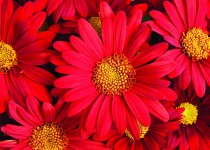The Newest Trends For Blooming Potted Plants

The operative phrase in 2012 for blooming potted plant producers is “what’s new?” be it new genetics, new uses for familiar plants or new ways to market products.
“What we’re seeing is that sales of your more traditional pot plants have probably declined over the past two or three years,” says Kevin Roethle, head of new product development at Ball Seed. “We can pretty confidently say we’re looking into different types of opportunities, some different plants and really trying to find the next new pot plant.”
Roethle cites celosia ‘Intenz,’ a Ball Seed/Ball Ingenuity introduction, as a successful example of a new pot plant that pleases both consumers and growers.
“I think the selling point we’ve seen consumers gravitate toward is the color. It’s very distinct – it’s a bold color, it’s a bright color. It’s easy to maintain. In that aspect, ‘Intenz’ has really resonated with consumers.”
Roethle adds that growers like the more compact habit, which makes it better for distribution.
Other new plants Roethle is betting on this year are two new members of the Dahlietta series: ‘Julia,’ which is a spectacular canary yellow color, and‘Lily,’ a new salmon color with a superb flower shape and doubling.
“We see Dahlietta as another series that’s done a lot of work to meet the grower’s side of things and has consumer appeal with the wide range of colors,” Roethle says.
Ball’s Blooming Potted Contribution
Dianthus ‘Scarlet Evolved’ is a new, deep red addition to the SuperTrouper series from Selecta North America. Roethle says pot carnations have caught on in the last five years due to the broad range of colors available, their compact habit and their toughness once they reach the hands of consumers. The SuperTrouper carnations are excellent pot or garden plants, he says.
Another new introduction from Ball Ingenuity is the Funtastic gerbera series, featuring Canary, Mango, Fire Orange, Blush, White, Enduring Burgundy and Yellow. This series displays exceptional heat tolerance, Roethle says.
“In the Southeast a lot of gerberas have problems in the summer when it’s really hot and really humid; they get diseases and tend to go down,” he says. “But this series is bred to be able to handle those types of conditions.”
Roethle points out that ‘Funtastic Mango’ was trialed at the University of Georgia this year and was a Plants of Distinction selection at least three times in the summer and early fall.
“It’s a high accolade, because that is a good heat tolerance trial,” he says.
Roethle sees an increasing interest in patio plants, so plants that can cross into that area are of special interest.
“The Funtastic gerbera is one you could say is a pot plant but really moves the bar in terms of being able to use it as a patio plant as well,” he says. “In terms of growth opportunity, [the patio plant market] is probably growing faster than your traditional year-round pot plant program.”
Roethle’s position with Ball Ingenuity was created 18 months ago, and he now spends 100 percent of his time with Ball working with third-party breeders to bring new genetics to North America. One result of the new position is Ball’s Double Gloxinia, with large, showy, double flowers and a fast finish time – eight to 10 weeks from liners. Bred by Logan Nursery and available through Ball Ingenuity, this series features flexible leaves on sturdy plants, allowing easy sleeving and shipping. Its colors include Suspense (deep purple), Fuchsia, El Grenada (red), Orchid, Watermelon, Perfect Double Purple, Perfect Double Red, Perfect Double White and Purple Tigrina.
“This is an example of a new take on an old plant,” Roethle says. “We found a breeder whose passion was gloxinia, and he had developed this line of really large, double-flowered plants. [It is] a very striking flower, and I think the growers who have taken this plant on and have been able to fit it into their growing regime and distribution models have done really well with it.”
Roethle adds that several growers have finished ‘Perfect Double Red’ and ‘Perfect Double White’ for the holiday season as an alternative to poinsettias – not replacing them, but using the double gloxinias as an addition to their holiday assortment.
New Player To The U.S.
Beekenkamp Plants is also introducing several new Christmas plants in 2012. Poinsettia ‘Saturnus Twist’ is a deep scarlet red with a bit of a ruffle on the flower bracts. ‘Portia Red’ and ‘Charon Red’ are also new.
Martijn Kuiper, Beekenkamp’s North American sales manager, says consumers might not notice a difference with ‘Portia Red’ and ‘Charon Red,’ but growers will like that they are easy to grow, branch well and do not need large amounts of growth regulators. The two varieties are also not prone to botrytis and other diseases.
“Growers are not making a lot of money on poinsettias so they need as easy a crop as possible,” Kuiper says.
A new Beekenkamp cyclamen, Bellissima, is a large (5- to 6-inch) bell-type with fringed petals. It’s now available in white and a white and purple mix, but Kuiper says they are being bred for more color. A Cyclamen persicum series, Maxiwella Bells, is another 5- to 6-inch bell-type, that’s new to the North American market. It comes in eight colors.
Additionally, because Beekenkamp is the largest producer of young begonia plants in Europe, it’s no surprise Beekenkamp wants to bring begonias to the U.S.
“We’re trying to bring the living room outside, so we’re breeding begonias also for outdoor use,” Kuiper says. “We are growing for the patio and outside market as much as possible.”
In other areas, Kuiper sees a decline in year-round potted products.
“Normally with begonias, you could have year-round availability, but that market is really declining. So we’re getting peak-season products; [for example] begonias more for spring and also a little bit for fall – that kind of product production.”
Kuiper is particularly proud of two new Begonia elatior introductions: ‘Lax’ (peach) and ‘Glory’ (pink), which offer more consistent branching and flowering on all sides of the plant. Beekenkamp also has four new varieties of Kelos celosia this year in Magenta, Pink, Purple and Scarlet. Kuiper says the Kelos are compact and ideal for fall production.
“Celosia has a really good shelf life,” he says. “I often joke that you could play soccer with it and it would survive.”
Mum’s The Word
“What’s new?” is also the operative phrase for Liz Hunt, senior market manager for Syngenta Flowers, the parent company of Yoder mums. For the pot mum market, “new” not only means new genetics but also new ways to present existing products.
Yoder’s Living Bouquets are multicolor pot mum container recipes that present existing mum varieties in a new way.
“The more traditional combinations like the Blush, where it’s all daisies – that’s been done for a number of years. That’s not new,” Hunt says. “What is new is using seedlings that are unrelated. So you are using some anemone flower forms and some daisy flower forms and different colors that maybe you wouldn’t necessarily combine.”
Hunt says Syngenta has combos suited for fall and some wintertime combinations designed for Christmas or Valentine’s Day. Pot mum growers are very traditional on the whole, she says, so they’re often skeptical of change. “But combos have been very well received by a lot of retailers, so that’s encouraging,” Hunt says.
Hunt strongly suggests growers use Yoder’s combo recipes, or trialing first, because varieties from seed can differ in timing or habit. Like other breeders, Hunt sees a consumer trend toward bold colors, and that is reflected in the new mum cultivars.
Two new mum introductions, ‘Purple Springs’ and ‘Red Springs,’ offer bold colors and a unique flower form.
“‘Purple Springs,’ for example, is starting to almost not even look like a pot mum,” Hunt says. “‘Red Springs’ is also a great red color, but with an anemone center to it – not a typical daisy, adding a little bit of interest for the consumer.”
Another new, boldly colored introduction this year is ‘Sabine Bronze’ in the Fleurette series. Hunt says the series has been revamped over the last two years to offer more vibrant colors and a faster response time for growers – almost a week faster than some of the original Fleurette genetics.
And, because mums are still primarily a seasonal and holiday crop, another new introduction, ‘China Doll,’ a red with gold undertones, is being promoted for the Chinese New Year, which can be a big pot mum holiday.









